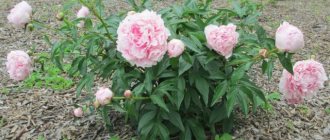Tatyana Panasenko Purchased peonies of the Henry Bockstoce variety
In 2016, I purchased the Henry Bockstoce variety. I can’t describe how I waited for the flowering; in 2022, a wonderful bush grew, but it didn’t have enough strength to flower, but this year it produced 6 flower stalks.
I sat down to study how to properly care for the plant and when to fertilize it.
I have collected a whole selection of interesting information.
| Peony Henry Bockstoce | |
| general characteristics | Terry, pinkish |
| Plant height | up to 90cm |
| Flower size | up to 20 cm |
| Color | Red |
| Bloom | Mid season |
| Winter hardiness | 3a(from -37.2C to -40C) – 8a(from -9.4C to -12.2C) |
History of selection
Peonies began to be grown as an ornamental plant in ancient China. Since then, breeders have developed about 5,000 new varieties with different characteristics and features. They differ in flowering time, bush shape and height, aroma and color. According to the existing classification, peonies are divided into three groups:
- Tree-like - perennials with woody shoots that do not die in winter, up to 2 m high.
- Herbaceous - shoots change annually.
- Ito hybrids are varieties created by crossing tree and herbaceous peonies; the stems die off in the fall.
The milky-flowered peony "Henry Boxtos" is an interspecific hybrid bred in 1955 in the USA. The originator of the variety is Bockstoce William S. Since then, “Henry Bockstoce” has spread throughout the world and a magnificent plant with giant red flowers can be seen in any garden.
"Henry Boxtos" - a hybrid with an average flowering period
Description and history of creation
The Henry Boxtos peony was brought to us from distant Canada, where breeders developed this variety. This herbaceous ornamental plant is very versatile in use and belongs to the interspecific peony hybrids. Representatives of this variety of peonies classify themselves as terry.
Peony "Henry Boxtos" has the following brief description:
- the stems of the flowers are quite massive and have good strength; large buds are perfectly fixed on them;
- the leaves have a light green color;
- the maximum height of a peony reaches 1 meter;
- the shoots are straight, flowers are visible on their tops one at a time;
- if there is a representative of this variety in the garden, there will be no limit to the delight from its appearance - the buds are presented in the shape of a huge ball, their diameter can reach 20 centimeters; the middle of the cup is painted bright pink; the petals are characterized by a tight fit to each other;
- the inflorescences have a very rich scarlet color;
- the flowering process begins at the beginning of the summer season - such a plant blooms no more than once; during the flowering period, such peonies emit a very pleasant aroma;
- one of the advantages is considered to be a high level of resistance to frosty weather; peonies of this variety are able to survive even at temperatures of 35 degrees below zero;
- "Henry Boxtos" is also very resistant to various pests that can cause diseases;
- Usually representatives of this variety of peonies do not need staking because of the strong stems, but many gardeners still resort to this method as additional protection of the plant from strong gusts of wind.
Peony is the same luxurious and spectacular flower as a rose, but less capricious and demanding to care for. According to reviews from experienced peony growers, the success of growing peonies depends 70% on the correct choice of varieties. If you focus only on the size, color and fullness of the flower, you can get a very capricious variety that requires even more attention than some roses. We present to you a description and photo of the best varieties of peonies - according to reviews from experienced gardeners.
All varieties of peonies are divided into 3 groups: tree-like, herbaceous and ITO hybrids. Herbaceous peonies are represented by varieties with juicy, tender stems that are prone to lodging to varying degrees. ITO hybrids are hybrids of herbaceous and tree peonies; they are much more expensive than herbaceous ones, but, unfortunately, they do not always please with the beauty of the flower, strong stem and resistance to rain and disease. Both in the second and third groups there are varieties that are recommended by all peony growers “with one voice.” We recommend starting your collection with them. But the choice of varieties of tree peonies often depends on the personal preferences of the gardener.
Description of peony Henry Boxtos
The perennial herbaceous plant has strong stems that can hold flowers without additional support. Peony leaves are twice trifoliate, pointed, light green with a yellow tint. Their length is from 20 to 45 cm. The roots are brown, thickened, spindle-shaped.
The peony bush "Henry Boxtos" is spreading, reaches a height of 1 m. At the top of the shoots, one bud is formed, which, after opening, turn into large, double, blood-red flowers. Their petals are dense, wide, with a satin sheen, and curved inward. The flower head is spherical in shape and reaches 20 cm in diameter. When blooming, the outer petals deviate outward from the center.
The abundant flowering of the Henry Boxtos peony is observed in early summer and is accompanied by a pleasant, strong aroma.
Peony variety Henry Bockstoce
- Variety name in Russian: “Henry Boxtox”
- Country of origin: Netherlands
- Bush height: 0.9 m
- Location on the flower bed: with direct sunlight
- Soil requirements: moderate humidity
This is an early variety that does not have a pronounced smell. It will not give you an enchanting aroma, but it will more than give you visual splendor! The fact is that this variety of peonies has stunning flowers: they are as double as possible, painted in garnet color, the petals shine and shine in the sun. The inner petals form a tight bud inside the flower, which the side petals carefully encircle. If you cut a flower right down to the sepal and take it in your hand, it will be visually impossible to find the place where it was attached to the stem.
Application in design
When choosing a place in the garden for the milky-flowered peony Henry Bockstoce, you should take into account the size of the bush and allocate sufficient area for it. The plants thrive in individual plantings and look impressive against the backdrop of a neatly trimmed, lush green lawn. Perennials look no less interesting against the background of conifers - spruce, juniper, thuja.
Peony blooms once - in the first half of summer
Landscape designers recommend combining the Henry Boxtos peony with clematis, phlox and roses. It is used in the design of mixborders created from continuously flowering perennials.
You should not place plants in flowerpots, even large ones. The root system needs sufficient space, and if it is limited, the Henry Boxtos peony feels depressed and stops blooming.
Important! Henry Boxtos peonies do not like acidic soil; soil with a neutral reaction is more suitable for them.
What kind of variety is this
The Henry Bockstoce peony was bred by Canadian specialists. The interspecific hybrid immediately became desirable for many gardeners.
Description and characteristics
The bushes reach a height of 80-100 cm. The shoots are straight, buds develop at the top of each of them. The color of the double flowers is garnet-red. When in bloom, the inflorescences reach a size of 20 cm. They emit a delicate aroma.
How the Henry Bostox variety blooms
Under the influence of large flowers, the shoots will bend, so some gardeners use a garter. Peonies of this variety are resistant to frost and have good immunity.
For your information! Several generations of a family can admire the bush, since it can grow in one place for 100 years.
Advantages and disadvantages of the variety
Positive qualities include the following characteristics:
- beautiful appearance;
- possibility of use for cutting;
- frost resistance;
- good immunity;
- drought resistance.
Disadvantages include lodging of shoots in strong winds.
Use in landscape design
Peony Henry is planted alone or in combination with other plants. Lush bushes look beautiful next to evergreen conifers. They are also planted near gazebos, in flowerbeds, and in mixborders.
Single planted Henry Bostocks
Compositions made from peonies of different varieties look impressive.
Reproduction methods
The easiest and most effective way to propagate the Henry Boxtos peony is by dividing the rhizome. To carry it out you need to perform a number of sequential actions:
- At the end of August, cut off the above-ground shoots of the plant by a third.
- Carefully dig the rhizome out of the ground.
- Carefully free it from the soil by rinsing it with water.
- To make the roots elastic, lower them into the cellar for several hours.
- Prepare a sharp, disinfected knife.
- Cut the rhizome into pieces so that each has full roots and several buds.
- Treat the cut areas with a solution of potassium permanganate, crushed coal or wood ash.
Important! Peony rhizomes that are at least 5 years old are suitable for division.
There are other methods of reproduction that are used extremely rarely. The cutting method is very labor-intensive and ineffective. Reproduction of the Henry Boxtos peony by seeds leads to a deterioration in its species qualities, since it is a hybrid. A plant grown in this way blooms in the sixth year.
When propagating a peony by division, pay attention to the condition of the kidneys
Peony family in the garden
With the first warm days of spring, reddish shoots of peonies appear in gardens and parks. By the end of May, bushes are formed and buds are identified. Almost every shoot ends in a pink flower.
Peonies attract with large, mostly double flowers of white, pink, and all shades of red, which exude a delicate sweetish aroma
Peonies are easy to care for, not demanding on soil and lighting, and respond to attention with abundant annual flowering.
Almost every garden has one or more peony bushes. For a long time, gardeners had little interest in the varieties of this flower, being content with the variety of colors - white, pink, red. Today, varietal bushes occupy an increasing place in private gardens and park flower beds.
Planting and care
The optimal time for planting Henry Boxtos peonies is the end of August or the first ten days of September. At this time, it is convenient to dig up and divide the rhizome into “divisions”. Planting at the end of spring is acceptable, but in this case flowering will occur only in the next season.
For perennials, choose a sunny place, sheltered from northern winds. The soil should be loose, well-drained, with a neutral reaction. Peonies tolerate swampy soil and excess moisture worse than its lack. You should not plant the peony “Henry Boxtos” in low parts of the site or near structures where drifts are possible in winter and stagnation of water in spring after the snow melts.
As planting material, select “cuts” with 2-3 buds without damage, rot or cavities.
Important! Choosing a rhizome that is too large can cause the plant to refuse to flower after a few years.
To prepare for planting, the Henry Boxtos peony is dipped in a solution of potassium permanganate for 1 hour, after which it is powdered with ash or coal. If planting is delayed for some time, to reliably preserve the rhizome, it is wrapped in damp moss and craft paper.
When planting plants, adhere to the following algorithm:
- Dig a hole 60x60x60 cm.
- Place two buckets of rotted cow manure in the bottom.
- Pour 3 buckets of a mixture of garden soil, compost and ash on top.
- Place the “delenki” in the center of the planting hole so that the buds are at least 3 cm above the surface.
- Fill in the rhizomes and compact the soil a little.
- Water and mulch the soil.
Important! If the buds are not deepened correctly, the Henry Boxtos peony does not bloom.
Pomegranate peonies “Henry Boxtos” look very advantageous next to white and pink varieties
Growing a flower, how to plant it correctly in open ground
In order for the plant to develop normally, it is necessary to carry out planting work correctly.
Planting with root cuttings
Rose Henry Kelsey - planting and caring for the crop
To plant from root cuttings, it is recommended to select and dig up a healthy bush, and then carefully divide it into fragments. Each part should include roots and 2-3 buds.
What time does boarding take place?
It is recommended to plant peonies in late summer or early autumn. Planting material is often sold in stores in February or March. In such a situation, spring planting is acceptable.
Selecting a location
The peony should be planted in a well-lit area. It should not be swampy or too low. Peonies can suffer from stagnant water, which negatively affects root development.
How to prepare the soil and flower for planting
Long peony roots need to be trimmed to 10-15 cm. To disinfect them, you should use a solution of potassium permanganate. To speed up the rooting process, you can sprinkle the roots with a growth stimulator.
The bed needs to be cleared of debris and dug up. It is recommended to add sand and black soil to heavy and clayey soil. It is important that the soil is loose and permeable.
Step by step landing procedure
- Dig a hole measuring 90x90 cm.
- Place a drainage layer on the bottom.
- Add substrate.
- Place the seedling in the hole, straighten the roots and sprinkle with soil.
- Compact the soil and water.
Important! It is not recommended to deepen the root collar too much. To retain moisture in the soil, it must be covered with a mulch layer.
For peonies to grow well, they need to be planted correctly.
Planting by seeds
Gardeners usually do not use this propagation method. It does not allow the characteristics of the mother plant to be preserved. Most often it is used by breeders to obtain new varieties.
Features of cultivation
Peony "Henry Boxtos" is an unpretentious plant that does not require special care. For its growth and development, it is necessary to water, fertilize, loosen and mulch the soil in a timely manner.
The perennial is moistened as needed, maintaining the soil at medium moisture. Watering of young plants that are at the stage of rooting and beginning of the growing season is monitored more carefully. Despite the ability of the Henry Boxtos peony to survive drought, you should not allow the soil to dry out. In hot weather, about 2 buckets of clean, settled water are poured under an adult plant in the evening.
Weeding is especially necessary during the first time after planting. Weeds are removed, and the soil around the Henry Boxtos peony is carefully loosened without damaging the roots located in the top layer. Immediately after loosening the soil, mulch it to slow down the drying process. For this purpose, dry grass, leaves and straw are used.
The plant needs periodic feeding, thanks to which it actively develops and blooms profusely. Both organic and mineral fertilizers are used. Phosphorus-potassium fertilizing is used twice - during budding and immediately after flowering.
Plant care
In order for the plant to develop normally and bloom luxuriantly, it is necessary to provide it with high-quality care.
Watering and fertilizing
Peony Duchesse de Nemours - growing a variety in the garden
The plant requires moderate watering. Only during active flowering the soil is moistened more abundantly. In the first year of cultivation, peonies should be fed. This ensures the formation of healthy roots. It is best to use preparations with minerals.
Important! After flowering is completed, strengthening components should be added to the water. Potassium and phosphorus are suitable for this.
Mulching and loosening
The root system develops upward, so the soil around the bushes should be carefully loosened. The soil should be added to the shoots. Mulching the soil is important. It helps retain moisture in the soil.
Preventative treatment
In unfavorable conditions, there is a risk of peonies being affected by diseases and parasites. To prevent the occurrence of problems from the root circle, it is worth removing weeds, leaves and carrying out preventive treatments. To do this, insecticides are used 3 times during the season.
Protection from diseases and pests
According to expert reviews and species descriptions, the Henry Bockstoce peony is resistant to diseases and pest damage. With incorrect agricultural practices and unfavorable environmental conditions, there is a risk of a number of diseases:
- gray rot is a fungal disease that affects shoots in spring or autumn, which leads to their drying out;
- root rot - the appearance of a white coating on rhizomes that rot and the entire plant dies;
- rust - brown spots on leaves with a dark border and swellings with fungal spores on the back side;
- mosaics are a viral disease that manifests itself in the form of a marble pattern on leaf plates.
To combat pathologies, the Henry Boxtos peony is treated with fungicides three times a season. For prevention purposes, you should use a clean, disinfected tool for cutting shoots, remove wilted leaves, buds and stems, and if the damage is significant, dispose of the entire plant.
Some insects cause significant damage to Henry Boxtos peonies. Among them:
- aphids - located on the leaves in groups, eat the buds, suck out the juice, which leads to wilting; insecticides are used to combat them;
- the bronze beetle is a bright beetle with a golden color that eats the entire flower; the most effective methods of destruction are manual collection of pests or the application of Medvetox or Thunder under the bush;
- root-knot nematodes are microscopic pest worms that attack the roots; such a plant must be dug up, burned, and the hole treated with a solution of 1% formaldehyde.
How to Care for Henry Bostox
Caring for a newbie is simple, like all representatives of the peony family.
- Weeding;
- Loosening;
- Feeding;
- Watering;
- Trimming.
Weeding consists of periodically removing weeds, especially between the stems of the bush.
Since the rhizome tends to grow upward, when loosening you should do the following:
Not deep; Carefully; Adding soil to the trunks.
Feeding. A young peony needs to be fed in the first year of its life in a new place, the small roots are still weak, the new ones are just growing, they need increased nutrition. Fertilizers - a solution of mullein or complete mineral fertilizer is applied to circular holes near the bush.
After flowering, it is advisable to add phosphorus and potassium to the water for irrigation to strengthen tissues and regenerate buds.
The root system of an adult plant penetrates to a depth of 80 cm, which ensures the viability of the bush in unfavorable periods. In normal times, the plant needs enough nutrients added to the soil during planting and supplied during periodic feeding.
Early pruning is harmful to the plant. Shoots need to be pruned only after they have been lodged, during pre-winter preparation, and to ground level. The rest of the time they serve as a source of food for the roots, which accumulate strength for wintering.
Interesting Facts:
- Peony does not tolerate shade, stagnant water and acidic soil.
- Healthy plants retain a beautiful, fresh appearance until autumn. The foliage changes color three times during the season, depending on the variety it becomes yellow, pinkish, bronze, green, creating an original decoration for the front garden.
A little care and attention, and young Henry Bostocks, a couple of years after planting, will surprise the owners and their guests with abundant flowering.
Preparing for winter
Henry Boxtos peonies are frost-resistant, tolerate temperature changes well and most often do not require additional shelter for the winter. To prepare the plant, after the first autumn frosts, the drooping stems are cut off, leaving no more than 3 cm. The shoots are removed from the site and burned to prevent the spread of spores and fungi.
In regions with a harsh climate and little snow in winters, it is worth mulching the pruned Henry Boxtos peony bush with dry sawdust, leaf litter, humus, loose compost, or using a breathable covering material for this purpose. If necessary, in winter the peony is additionally covered with snow.
Important! With the onset of spring, the covering material is removed and the mulch is raked away from the shoots to prevent the buds from rotting.
Care after flowering
In order for peonies to bloom next year, you need to correctly implement agrotechnical practices.
Transfer
Overgrown Henry Bockstoce paeonia bushes are divided and replanted. If this is not done, the buds will become smaller and weaker every year. The best time for the procedure is the end of August or the beginning of September. Plant the separated plants in a sunny place, not blown by cold winds.
Note! If transplanted in spring to the wrong place, peonies may never bloom.
Trimming
The above-ground part is cut off in late autumn after the shoots have lodged. The procedure is performed with a sharp, disinfected pruning shears. Early pruning can harm the plant: the root system will not receive enough nutrients, the conductor of which is the shoots.
For the winter, dried shoots are cut off
Preparing for winter
At the end of August, peonies are fed with a potassium-phosphorus mixture. In autumn, moisture-recharging irrigation is carried out. Being in moist soil, the root system can more easily withstand frost. For the winter, the bushes are mulched with peat or compost.
For your information! This variety does not require shelter for the winter.











